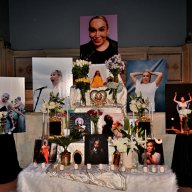Glamour in a museum; the beauty of Michael Powell; cuteness in Japan
The history of Manhattan society and culture, as seen through the clothing of the rich and famous, is the focus of “Glamour, New York Style,” at The Museum of the City of New York, running through July 4.
New Yorkers should be better acquainted with this treasure of an institution, not to mention all the delicious, low-cost Spanish Harlem restaurants nearby. For me, it’s always worth a trip, if only to see that incredible dollhouse designed by Carrie Stettheimer, who along with her sisters, Florine and Ettie, flourished at the center of Manhattan’s art world in the ‘20s. It’s charmingly populated by celebrities like Carl Van Vechten, and decorated with miniature artworks by the likes of Marcel Duchamp and Gaston Lachaise.
For “Glamour, New York Style,” curator Phyllis Magidson has assembled a magnificently varied collection of Gotham drag, which ranges from a gown worn to George Washington’s inauguration to the funky leather ensemble Alicia Keys wore to the MTV Video Music Awards, designed by Jordan Bettan of Lost Art. For Magidson, these garments clearly express that crucial ethos of glamour, which basically consists of who you are, where you go and what you buy.
In 1966, the place to go to was Truman Capote’s fabled Black and White Ball at The Plaza. Representing this legendary evening is Candice Bergen’s Halston-designed black velvet dress and white mink bunny mask, which the actress says took her 20 years to live down. You can see the original engraved invitation, as well as fanciful masks designed by Bill Cunningham, one of New York’s most beloved and knowledgeable paparazzo.
A lesser-known diva is on display: Mona, Mrs. Harrison Williams and later the Countess of Bismarck, who was so chic that, when Balenciaga retired, this international socialite forever closed her own doors as well. An ethereal Vionnet gown attests to the exquisite taste of this Louisville, Kentucky-native, who rose from the humblest of beginnings to become the fashion icon of her day.
The theater world also gets its due—Patti LuPone’s famous “Dior” ball gown from “Evita,” Anthony Powell’s leopard skin madness for Betty Buckley in “Sunset Boulevard,” and even a scarlet dress Badgley Mishka created for Lypsinka to wear to a ‘90s Love Ball charity event. But my favorite piece in the show is a gold suit of armor the brilliant Jo Mielziner made for Katharine Cornell’s 1936 “Saint Joan.” It’s an outrageous flight of fancy, more Hollywood, really, than George Bernard Shaw. It must have transformed that first lady of the American Theater into nothing less than a human Oscar.

The Museum of the City of New York is located at 1220 Fifth Avenue at 103rd Street. For more information, visit mcny.org or call 212-534-1672.
All true cinema lovers should head directly to the Walter Reade Theater for “Michael Powell: Beauty Unending,” through the end of May, a 100th anniversary celebration of that greatest of British directors. Where most filmmakers merely have stories to tell, Powell gave you entire worlds to explore—the ballet, with all of its dizzying color and gorgeous melodrama (“The Red Shoes”); a mythical Hebrides island where Wendy Hiller finds pure enchantment (“I Know Where I’m Going!”); the “Arabian Nights” tales, done to a stunning fare-thee-well (“The Thief of Bagdad”); heaven and earth itself (the fantastical “A Matter of Life and Death”); the mind of a serial killer (“Peeping Tom,” the daring film which ended Powell’s commercial viability).
It’s no secret that Powell’s usage of color ranks among the medium’s finest, but I must say that I recently watched a DVD of his “Black Narcissus” on a high-definition screen and it was breathtaking, perhaps the single most beautiful screening experience I have ever had. I met the great man years ago, at a Museum of Modern Art party in his honor. It was particularly memorable for the fact that it took place in a rather small office room, where, in the far corner, sat an avowed Powell fan, none other than Martin Scorsese. I was near the door and saw his ex-wife Isabella Rossellini enter, looking stunning, with her then-lover David Lynch. They took one look into the room and beat the hastiest retreat.
Meanwhile, Powell, for all of his curmudgeonly rep, was graciousness, itself. He gave me a full, non-stop interview—while doing certain men’s room ablutions, no less!—about all the wonderful costumers he’d worked with. He recalled how painstaking Oliver Messel was on “The Thief of Bagdad,” hand-crafting and painting so many of the costumes, while Jacques Fath (“a lovely boy”) transformed Moira Shearer into a fairy tale princess for a crucial audition scene in “The Red Shoes.”
Try and check out some of the lesser-known titles in Powell’s oeuvre. The 1936 “Her Last Affaire” (May11-12) is bang-up: from the first scene, where Viola Keats, an intriguing Scot actress about whom I know nothing, is being thoroughly examined by her doctor. (“Cough again.” And then, “Please, this isn’t the last act of ‘Boheme’!”) It’s a witty, fast-paced melodrama about an adulterous wife who goes too far and pays for it. Deliciously Deco and wonderfully cast, it features a very young, very funny Googie Withers, as a bumptious inn maid who, when told by her pretentious employer that “Queen Elizabeth slept in that bed,” slyly mutters, “Takes you back, don’t it?”
A fascinating look into the psyche of modern Japan presents itself in “Little Boy: The Arts of Japan’s Exploding Subculture,” at the Japan Society, 333 E. 47 St., through July 24. “Little Boy” was the nickname given to the atomic bomb dropped on Hiroshima in 1945, and much of this show’s content reveals a crucial national need for extreme escape from that horrible reality. It’s interesting that, apart from an exhibit devoted to Godzilla, who symbolized the brutality of the A-bomb, the show mostly avoids “ugliness” of any kind, and is overwhelmingly more about a certain precociousness, which sometimes even borders on infantilism.

The show is curated by Takashi Murakami, an artist ironically most famous for those ubiquitous, jazzed-up Louis Vuitton bags you see everywhere from Park Avenue to Canal Street. Indeed, the absolute blurring of the line between “commercial” and high art seems to be the prevailing theme of the show. The all-important ethos of kawaii, or cuteness, emerges in a majority of the works, from Chiho Aoshima’s painting, “City Glow,” with its fanciful butterfly-strewn urban view to the heavily represented Sanrio Corporation (the guilty ones responsible for “Hello Kitty”) to Ohshima Yuki, who was so fragile and shy himself when I met him, that he resembled one of the achingly precious figurines he creates.
Those enormous, Bambi eyes Japanese commercial artists have traditionally employed are prevalent throughout the show. This exaggerated embrace of a Western ideal of beauty has always intrigued me, ever since watching the cartoon, “Speed Racer” (also represented in the show) as a child. As other races have nose jobs, certain Asians, for years, have gone in for a surgical eyelid sewing that widens the eyes and, it seems to me, that this particular manifestation of physical self-disdain could well merit some serious artistic comment, as well.
Contact David Noh at Inthenoh@aol.com.
gaycitynews.com



































